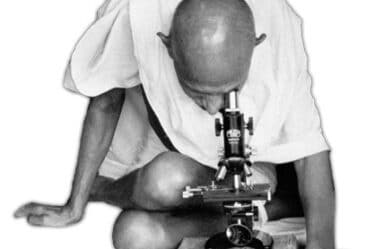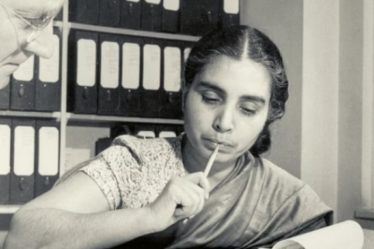Shri Prabhakar Joseph, affectionately known as Prabhakarji, was a beacon of humility, dedication, and unwavering commitment to Gandhian principles. His journey from a modest background in Andhra Pradesh to becoming a pivotal figure at Sevagram Ashram is a testament to the transformative power of selfless service.
Born into a community where meat consumption, including carrion, was customary, young Prabhakar’s early life was marked by hardship and limited educational opportunities. His mother, a hospital attendant, struggled to provide for the family, often resorting to toddy to cope with their circumstances. Despite failing the matriculation examination twice, Prabhakar’s enrollment at the Andhra Jateeya Kalasala became a turning point. There, he encountered Young India, the publication that introduced him to Mahatma Gandhi’s ideals. Inspired by Gandhi’s writings on cow protection and non-violence, Prabhakar renounced meat, toddy, and other past indulgences, embracing a path of self-purification and service.
In 1940, Prabhakar arrived at Maganwadi in Wardha as a Harijan student, receiving training in paper-making, bee-keeping, and soap-making. His commitment to Gandhian values caught the attention of Mahadev Desai, who introduced him to Gandhi. A notable incident from this period, documented in the Harijan dated September 15, 1940, recounts Prabhakar’s heartfelt confession about his past dietary habits and his decision to abstain from milk as penance. Gandhi, moved by his sincerity, persuaded him to resume milk consumption, emphasizing the cow’s unparalleled service to humanity.
Prabhakarji’s full name was Prabhakaran Joseph. After completing a ten-month training in village industries at Maganwadi, instead of returning home, he chose to go to Sevagram Ashram. So deeply did he immerse himself in the life and spirit of the Ashram that he never thought of going back. For him, the Gandhi Ashram became more than a home—it was his life’s calling.
Embracing the ashram life wholeheartedly, Prabhakar became an integral part of the Sevagram community. His humility, diligence, and ever-smiling demeanor endeared him to all. He worked closely with Dr. Sushila Nayar, tending to patients during malaria outbreaks and establishing a small dispensary that eventually evolved into the Kasturba Hospital, now a 600-bedded teaching hospital affiliated with the Mahatma Gandhi Institute of Medical Sciences.
His ever-smiling face, swift movements, readiness to work, humility, and gentle manners endeared him to all. But such qualities alone did not suffice for membership in the Ashram. He was carefully assessed by the late Mahadev Desai, who found him to be an ideal candidate for Ashram life. Bapu (Gandhiji) himself engaged in discussions with him and ultimately agreed to let him stay as an inmate.
In those days, Wardha was notorious for its high burden of malaria. With the onset of the monsoon, nearly every household would report at least one case, and the Ashram was no exception. Many residents were bedridden with high fevers exceeding 102°F. Recovery often required a week of devoted care before the patients could regain their strength. Nature cure methods were employed—mud packs applied to the forehead and abdomen, and enemas to cleanse the bowels.
Prabhakarji cared for the sick with a mother’s tenderness. His selfless service brought him close to the late Dr. Sushila Nayar, and together they established a modest dispensary in one of the Ashram’s rooms. Stocked with just a few essential medicines and disinfectants, the dispensary soon saw a growing number of patients.
At Gandhiji’s suggestion, the dispensary was moved out of the Ashram to a newly constructed guest house, a few furlongs away, which had been built by the late G.D. Birla for Gandhiji’s visitors. Gandhiji preferred his guests to stay with him in the Ashram, so the guest house was repurposed into a five-bed hospital. This modest beginning marked the genesis of five-bed Kasturba Hospital, which today is a 1000-bed teaching hospital affiliated with the Mahatma Gandhi Institute of Medical Sciences.
When Dr. Sushila Nayar accompanied Gandhiji to the Aga Khan Palace prison and later to Delhi—and subsequently left for the United States to pursue a doctorate in modern medicine—it was Prabhakarji who continued to manage Kasturba Hospital. He was assisted by Dr. R.V. Wardekar, who would later go on to found the renowned Gandhi Memorial Leprosy Foundation. Two other dedicated workers played key roles in this journey: Dr. Anant Ranade, an Ayurvedic physician who performed thousands of cataract surgeries around Sevagram and pioneered a community-based health insurance scheme; and Manimala Chaudhary, the hospital matron who later became the Secretary of the Kasturba Health Society.
Prabhakarji played a key role in staffing the hospital. He recruited local villagers, trained them, and transformed them into dependable and dedicated healthcare workers. They later became the backbone of the newly established Mahatma Gandhi Institute of Medical Sciences.
Following Gandhiji’s passing, Prabhakarji returned to serve the Ashram. After four or five years, he temporarily left to participate in the Bhoodan movement in Andhra Pradesh. Though it was a diversion, his heart remained firmly rooted in the Ashram. When Sevagram Ashram Pratishthan was later constituted as a separate registered body to manage Ashram affairs, Prabhakarji was appointed its first Secretary. The Chairman was Sriman Narayanji Agarwal, son-in-law of Jamnalalji Bajaj.
Prabhakar’s leadership extended beyond healthcare. He played a crucial role in training local villagers, integrating them into the ashram’s various initiatives. His commitment to rural development and social upliftment was evident in his involvement with the Bhoodan movement in Andhra Pradesh. Recognizing his dedication, he was appointed the first Secretary of the Sevagram Ashram Pratishthan, working alongside Sriman Narayanji Agarwal, the Chairman.
However, his journey was not without trials. In the 1970s, a tragic incident occurred when an electrified fence, installed without his knowledge to protect the ashram’s orange orchard, led to the deaths of a female worker and her daughter. The ensuing outrage from the local community threatened the ashram’s existence. Prabhakar’s presence and empathetic handling of the situation were instrumental in pacifying the agitated villagers, reflecting his deep connection with the community and unwavering commitment to Gandhian principles.
Incidentally, Dr. Prabha Desikan—an alumna of MGIMS and daughter of Dr. K.V. Desikan, a legendary figure in the field of leprosy, and Kamala Desikan, former Secretary of the Kasturba Health Society, Sevagram—owes her name to Shri Prabhakar. So deeply moved were Mr. and Mrs. Desikan by Shri Prabhakar’s life and work that when their daughter was born in 1967, they named her in his honour.
In 1978, the ashram faced internal unrest due to disparities in wages between ashram workers and those at the medical college. Prabhakar, always an advocate for fairness, supported the workers’ demands. However, his stance led to disagreements with other members of the management. In a move that contradicted Gandhian values of dialogue and consensus, he was unceremoniously removed from his position as Secretary. True to his principles, Prabhakar accepted the decision without protest and left the ashram.
Despite his declining health, he continued his relief work, particularly in the cyclone-affected areas of Andhra Pradesh. His relentless service took a toll on his health, leading to his demise on June 17, 1979. His passing marked the end of a life devoted to selfless service, humility, and unwavering adherence to Gandhian ideals.

